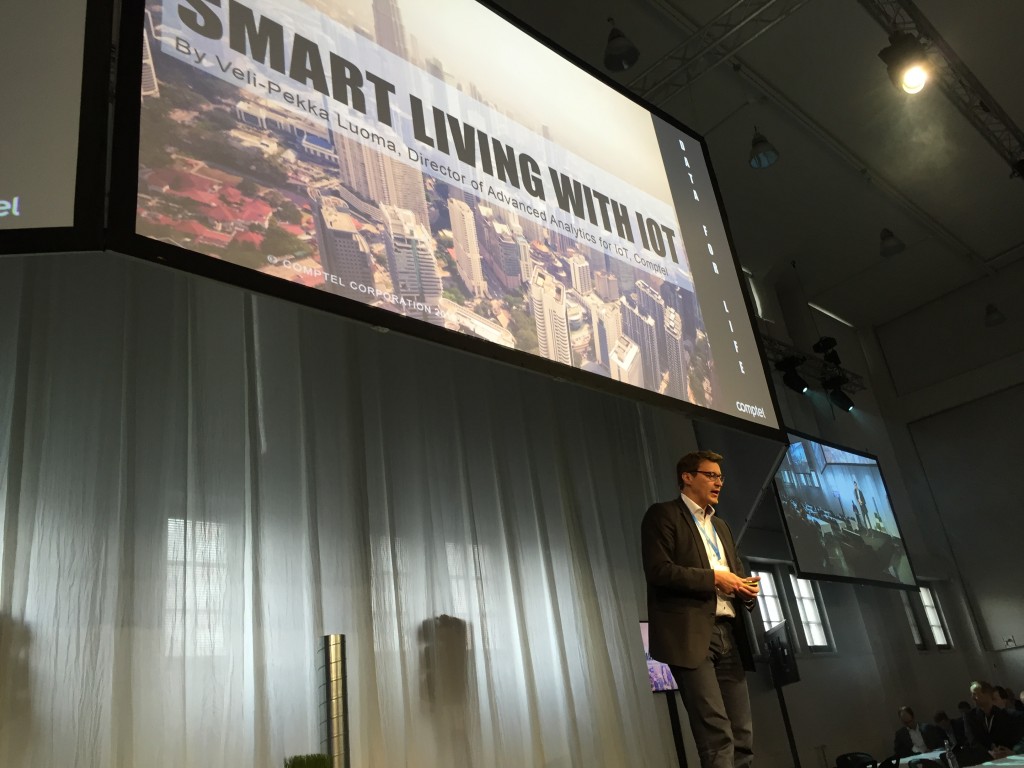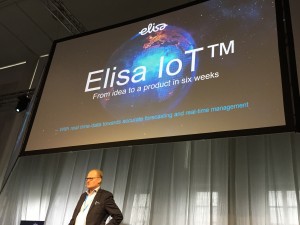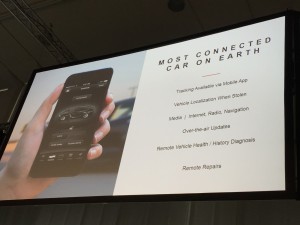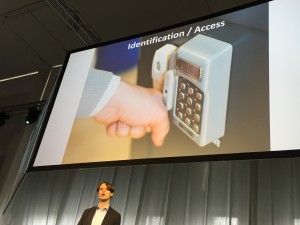#IoTNordic 2016 Recap: Spotlight on IoT Partnerships and Potential
Posted: May 17th, 2016 | Author: Malla Poikela | Filed under: Events | Tags: Intelligent Fast Data, IoT, IoTNordic | No Comments »Last month, a sold-out crowd of 500 IoT enthusiasts packed into Helsinki’s Kattilahalli conference hall for the Internet of Things 2016 Conference, also known as #IoTNordic. With a DJ playing live music throughout the two-day show, a saxophonist entertaining the crowd in the late afternoon happy hour and outdoor food vans offering tasty meals, the event offered a hip, modern and invigorating atmosphere for lively discussions on the potential and partnerships that define the IoT.

Veli-Pekka Luoma, Comptel
Although environmentalism was a major theme (event organisers used recycled wooden pallets as booth tables, for example), the event and the attendees were focused on different kind of environment: the holistic IoT ecosystem. There was one common denominator: Nearly everyone in attendance, across industries, was looking for technology partners to help them build or expand their own ecosystem of connected device solutions.
Comptel sponsored #IoTNordic and presented a speaking session with our Director of Advanced Analytics for IoT, Veli-Pekka Luoma, about the vital role data plays in the Smart Living movement. Comptel’s Intelligent Fast Data solutions offer businesses the power to sense, understand and act instantly on data “across the board.” Connected devices are another data source that produces aggregated information, alongside customer interactions, the network, social media, location and more. Businesses stand to benefit tremendously by pulling insights from all those different sources and applying insights to real-time actions. Those actions lead to better IoT-enabled experiences.
Industry can remotely monitor heavy machinery to run a “smart factory.” Health care providers can track personal data to offer intelligent preventative care, fleet managers can optimise routes for cargo vehicles, utility providers can provide efficient energy solutions with smart meters, and much more.
It all starts with smarter data. Through experimentation, partnership and solution co-creation, businesses – including operators – can apply data analytics to elevate the IoT beyond simple machine-to-machine communications toward humanistic benefits. #IoTNordic offered several compelling examples of businesses that are already succeeding in the IoT.
Elisa’s IoT Innovation Challenge

Elisa VP Markku Hollström
The Finnish operator Elisa has enjoyed many successes along its digital transformation. Its IoT service offering is one example. The company offers IoT connectivity, monitoring and analytics to a range of verticals, including a 3D real-time “Smart Factory” dashboard for industry, augmented reality solutions, and analytics-enriched monitoring and email notifications for the marine manufacturer Wärtsilä.
Elisa VP Markku Hollström explained that to succeed in the IoT, you need to experiment and develop a broad network of partners. That enables speed – the company profiled IoT projects that went from ideation to product in just six weeks. It’s also why the company is inviting businesses to participate in the Elisa Innovation Challenge, which will reward up to €85,000 in prizes to entrants who create innovative corporate and Smart Home IoT solutions.
Technology, Customer Experience the Focus for Tesla

Tesla presentation at IoT Nordic
The electric car manufacturer Tesla says it is not in the business of selling luxury vehicles. At the show, the company’s speaker said the company’s focus is actually in transitioning the world toward safer, sustainable transportation. The IoT plays a big role in that: Tesla says its vehicles are the most connected cars on Earth, and their mission is to incorporate technology to create a software-based, analytics-informed driving experience. Even their car buying experience is innovative; it’s entirely online, making it a modern, customer-focused approach to purchasing.
Are Device Implants the Future of Health?

Hannes Sjöblad, BioNyfiken
Hannes Sjöblad of BioNyfiken presented a fascinating look at the role of NFC implants in human health, which his company says is humanity’s “personal key to the IoT”. This technology already exists – in fact, we saw a live demo at the end of his presentation of a human implant placed into a person’s hand. While also a bit scary, the demo did show the amazing potential of implanted devices to enable everyday individuals to “speak” to connected devices.
There are simple but very relevant use cases, like replacing keys, ID cards, tickets and boarding passes with implanted chips, and use cases that are more humanistic. Personalised chips could ensure a gun can’t be operated by an unauthorised user, for example, or even play a role in curing blindness, deafness and paralysis.
Securing the IoT
Of course, any conversation about the many uses cases for the IoT eventually falls back on security concerns. In his keynote speech, Mikko Hyppönen, Chief Research Officer of F-Secure explained that the IoT will only expand the number of threat vectors (how do you secure your Wi-Fi if it’s being shared by your refrigerator?), creating more opportunity for highly sophisticated cyber criminals and making it more difficult for consumers to maintain privacy.
The number and variety of IoT devices will make single-device protection impractical, said Hyppönen. F-Secure, for example, has no interest in developing anti-virus protection for your connected toaster. However, the company does develop full-home Wi-Fi security solutions to ensure every device on the network is secure. Furthermore, F-Secure compensates independent hackers who find holes in their security system, when many of those hackers may have otherwise sold that information to cyber criminals. It’s a good solution for F-Secure: Paying for hackers to find holes in your system is a clever and efficient way to find vulnerable spots in your environment.
As Hyppönen said, ”Web content is not free. It is paid for with your data. It’s paid for with your privacy. And it’s too late to change that. We have raised a whole new generation who are used to having content for ‘free’ on the web. And yet, we don’t understand what this means.”
That’s an important takeaway to keep in mind as businesses and operators tiptoe – or dive head-first – into the futuristic world of the IoT.
Learn more about the IoT opportunity for telco in a new whitepaper from Comptel and Heavy Reading. Download “Smart Cities & Smart Living: The Role of Telecom Operators.”






Leave a Reply